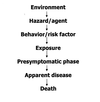Public health 101 for informaticians
- PMID: 11687565
- PMCID: PMC130068
- DOI: 10.1136/jamia.2001.0080585
Public health 101 for informaticians
Abstract
Abstract Public health is a complex discipline that has contributed substantially to improving the health of the population. Public health action involves a variety of interventions and methods, many of which are now taken for granted by the general public. The specific focus and nature of public health interventions continue to evolve, but the fundamental principles of public health remain stable. These principles include a focus on the health of the population rather than of individuals; an emphasis on disease prevention rather than treatment; a goal of intervention at all vulnerable points in the causal pathway of disease, injury, or disability; and operation in a governmental rather than a private context. Public health practice occurs at local, state, and federal levels and involves various professional disciplines. Public health principles and practice are illustrated by a case study example of neural tube defects and folic acid. The application of information science and technology in public health practice provides previously unfathomed opportunities to improve the health of the population. Clinical informaticians and others in the health care system are crucial partners in addressing the challenges and opportunities offered by public health informatics.
Figures







References
-
- Yasnoff WA, O'Carroll PW, Koo D, Linkins RW, Kilbourne E. Public health informatics: improving and transforming public health in the information age. J Public Health Manage Pract. 2000;6:67–75. - PubMed
-
- Public Health Functions Steering Committee. Public health in America. Statement adopted Fall 1994. Public Health Functions Web site. Available at: http://www.health.gov/phfunctions/public.htm. Accessed Jul 10, 2001.
-
- Centers for Disease Control and Prevention. Ten great public health achievements—United States, 1900–1999. MMWR Morb Mortal Wkly Rep. 1999;48:241–3. - PubMed
-
- Centers for Disease Control and Prevention. Changes in the public health system. MMWR Morb Mortal Wkly Rep. 1999;48:1141–6.
-
- Foster KR, Jenkins MF, Toogood AC. The Philadelphia yellow fever epidemic of 1793. Sci Am. 1998;279(2):88–93. - PubMed
MeSH terms
Substances
LinkOut - more resources
Full Text Sources
Medical

